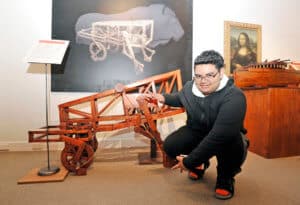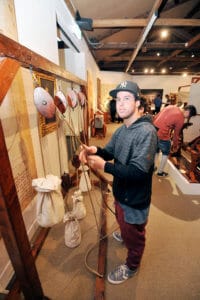 EIT Robitics student at Leonardo exhibition
EIT Robitics student at Leonardo exhibition
Tawhiro Wharawhara- Patuwai (left) gets up close and personal with a replica of Renaissance genius
Leonardo da Vinci’s wooden skeleton of a robotic lion. Da Vinci is thought to have created three robot lions. “The second lion, designed just before Da Vinci moved to Clos Luce, could walk under is own power and move its head,” says science correspondent for The Independent, Richard Gray. “It was presented to Francois I when Leonardo visited Lyons in 1515. When the king stepped forward and tapped the lion with his sword, its body opened and presented him with lilies.”
Renaissance robots constructed in timber and exhibited at Tairāwhiti Museum were viewed enthusiastically last week by students studying computing and robotics at EIT’s trades academy.
The touring exhibition of Da Vinci Machines and Robotics includes models of creations such as a hang glider, robotic lion and robotic drummer.
The Level 2 and 3 students’ visit was part of their research project into robotics, mechanisms and ideas, said tutor Steve Main.
In the one-day-a-week course in which secondary school students attend the Trades Academy to learn practical skills while working towards NCEA credits, the robotics class learns about the principles of engineering and physics.
“The Level 3 students use CAD (computer aided drawing) to design their own robot chassis and print them out on one of our new commercial 3D printers,” said Mr Main. The high-tech printers are the only ones of their kind in Gisborne.
“They have to code the robot and assemble the electronics themselves. The students start off with a commercial robot kit to understand the engineering and computing principles behind it, types of sensors, coding and some electronics theory. We lead them into using CAD drawing to make up their own robotic chassis.”
The chassis is then populated with motors, sensors and a programmable development board.
The aim of the project is for students to develop a fully autonomous robot that navigates a maze, said Mr Main.
Next year, the research project will centre on drone technology.
EIT Robitics student at Leonardo exhibition – Sam Kernohan (below)examines one of the interactive models in the show — a system of pulleys and counterweights. Story by Mark Peters & Pictures by Liam Clayton both from Gisborne Herald

